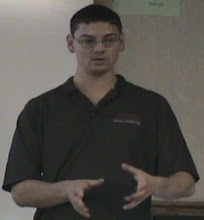This was passed my way by the author, José Luis Gómez-Muñoz: a Mathematica Add On for Quantum Computing. There is also a short 6 minute video that walks you through it on youtube:
I have not played with it yet, but the video does a great job of explaining what it can do. What I especially liked was the ability to view the circuit in different forms. As an example you could view the circuit in the more traditional 2 dimensional form as well as a 3 dimensional one. Additionally you can view things in matrix form and so on.
Definitely looks like a great tool to grab images for presentations. Furthermore it would be useful for students to double check work. I had to write my own complex matrix class for Cove and it would've been nice to have an easy to use tool such as this to compare against so I could more quickly verify my implementation.
Tuesday, February 23, 2010
13th Workshop on Quantum Information Processing Presentations
I came across this on Dave Bacon's blog last week: the presentations from the 13th Workshop on Quantum Information Processing (QIP 2010). If you're interested in the field, you're sure to find something of interest to check out.
Wednesday, February 17, 2010
An Invisible Quantum Tripwire
I came across this paper on arXiv today: An Invisible Quantum Tripwire. It is a short read (4) pages, and pretty interesting. It basically expands the bomb experiment, where the presence of a bomb can be detected without measurement- albeit with only a 25% chance of successful detection. (That cannot be done classically.) The paper also introduces that experiment.
Wednesday, February 10, 2010
Manipulating Lone Qubits

At Princeston Petta's demonstrated how to manipulate a lone electron. Another step forward towards physical implementations of quantum computers.
Tuesday, February 9, 2010
Quantum Algorithms Make Cover of Communications of the ACM

Quantum algorithms made the cover of this month's (February 2010) Communications of the ACM (CACM) in an article titled Recent Progress in Quantum Algorithms by Bacon and Van Dam. Having quantum computing make the cover of CACM shows that the field is moving more and more into the mainstream.
Not only is it exciting to see the article in CACM, but it is very well written and up to date. Many of the texts on quantum computing cover Grover's and/or Shor's. This article covered playing quantum games, simulation, and Shor's in addition to the more general finding hidden symmetries. They also explain quantum computing through the quantum coin toss (which I also did in my dissertation) and the drunkard's walk. At 10 pages I'd have to describe this article as an excellent intro to quantum algorithms and recent progress being made.
Wednesday, February 3, 2010
DARPA and Quantum Computing
DARPA (United States Defense Advanced Research Projects Agency) has a Quantum Entanglement Science and Technology (QuEST) program. You can find the website here, and is summed up well by the home page:
It shouldn't be too much of a surprised that DARPA is interested in the field. I think what is noteworthy is that the budget has been steadily increasing: 4.4 million in FY2008, 9.4 in FY2009, 14.1 in FY2010. (See page 26 here for the numbers.) I recognize that this isn't much money as far as government spending is concerned, but this is just what is publicized by DARPA. Given the potential of quantum computers, I wouldn't be at all shocked if there is more work going on behind closed doors. (Someone asked me about this during my dissertation defense.)
The objective of the QuEST program is to identify and address the most important outstanding challenges and opportunities, both experimental and theoretical, and resolve or exploit them to enable revolutionary advances in the field of quantum information science and technology.
It shouldn't be too much of a surprised that DARPA is interested in the field. I think what is noteworthy is that the budget has been steadily increasing: 4.4 million in FY2008, 9.4 in FY2009, 14.1 in FY2010. (See page 26 here for the numbers.) I recognize that this isn't much money as far as government spending is concerned, but this is just what is publicized by DARPA. Given the potential of quantum computers, I wouldn't be at all shocked if there is more work going on behind closed doors. (Someone asked me about this during my dissertation defense.)
Subscribe to:
Posts (Atom)
